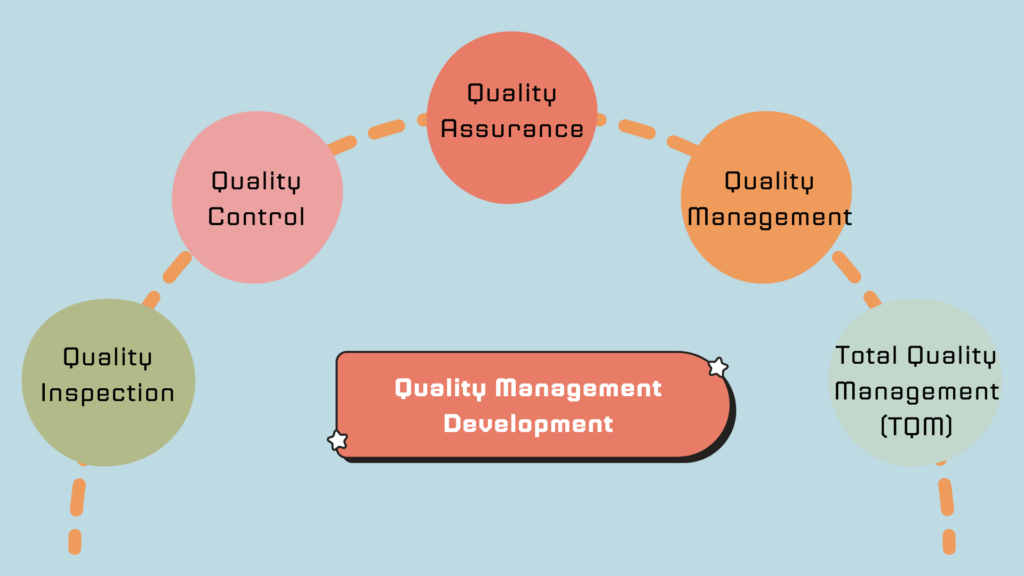The evolution of Quality Management Systems (QMS) has been a dynamic process shaped by changing business environments, technological advancements, and evolving international standards. Here is a brief overview of the key stages in the evolution of QMS:
Craftsmanship and Inspection (Pre-20th Century): In the pre-industrial era, craftsmanship and skilled artisans played a crucial role in ensuring product quality. Inspection was often the final step to identify and rectify defects.
Quality Control (1920s-1940s): The concept of statistical quality control, pioneered by Walter A. Shewhart and further developed by W. Edwards Deming and Joseph M. Juran, emerged during the early 20th century. Statistical techniques were employed to monitor and control processes, laying the foundation for modern quality management.
Quality Assurance (1950s-1970s): The focus shifted from mere inspection to a more comprehensive approach known as Quality Assurance. Companies began developing systematic processes to prevent defects rather than just detecting and correcting them. This period saw the rise of standards such as ISO 9001.
Total Quality Management (TQM) (1980s-1990s): TQM became a dominant philosophy, emphasizing a holistic approach to quality encompassing all aspects of an organization. TQM involved continuous improvement, employee involvement, customer focus, and process optimization. It drew heavily from Japanese Quality Management Systems practices.
ISO 9000 Standards (1987 Onwards): The International Organization for Standardization (ISO) introduced the ISO 9000 series, providing a framework for QMS. ISO 9001, in particular, became widely adopted, and its revisions reflected changing business paradigms and increased emphasis on customer satisfaction.
Six Sigma (1986 Onwards): Developed by Motorola and popularized by companies like General Electric, Six Sigma is a data-driven methodology aimed at minimizing defects and variations in processes. It became a widely adopted approach for process improvement and quality management.
Lean Manufacturing (1990s Onwards): Originating from the Toyota Production System, Lean Manufacturing focuses on eliminating waste, improving efficiency, and optimizing processes. Lean principles, often combined with Six Sigma, became integral to modern QMS.
Integration of Technology (2000s Onwards): The advent of digital technologies led to the integration of Quality Management Systems with software solutions. This facilitated real-time monitoring, data analysis, and automation of various QMS processes.
Risk-Based Thinking (ISO 9001:2015): The 2015 revision of ISO 9001 introduced a more risk-based approach, encouraging organizations to identify and address potential risks to their QMS. This shift reflected a broader perspective on quality management.
Industry 4.0 and Digital Transformation (Present): The ongoing evolution involves the integration of Industry 4.0 technologies such as the Internet of Things (IoT), artificial intelligence, and big data analytics into QMS. Digital transformation aims to enhance efficiency, traceability, and overall quality in a connected and data-driven environment.
The evolution of QMS continues as organizations adapt to emerging technologies, changing customer expectations, and evolving global business landscapes. The future is likely to see further integration of smart technologies, increased emphasis on sustainability, and continued refinement of quality management principles.
Conclusion
The evolution of Quality Management Systems (QMS) reflects a dynamic journey shaped by the changing landscape of business practices, technological advancements, and a growing emphasis on customer satisfaction. From the early days of craftsmanship to the sophisticated, technology-driven approaches of today, the evolution of QMS has been marked by a continuous quest for excellence, efficiency, and the reduction of defects.

